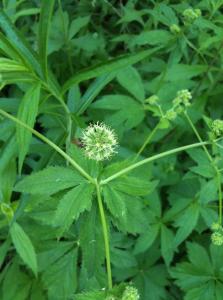

Britton, N.L., and A. Brown. 1913. An illustrated flora of the northern United States, Canada and the British Possessions. 3 vols. Charles Scribner’s Sons, New York. Vol. 2: 623. Provided by Kentucky Native Plant Society. Scanned by Omnitek Inc
Where Commonly Found: Moist forests on rich or rocky slopes, CT, MA, ME, NH, NY, RI, VT
How to Identify:
(For unfamiliar words: Wikipedia Glossary of Botanical Terms).
Go Botany Key for Sanicula marilandica.
Minnesota Wildflower’s description of Sanicula marilandica. Click on more images.
Flower Color: Greenish White
Flower Type: Umbels, pom-pom-like, at ends of branching stems, with 2 -4 small, 1/2″ round clusters, each comprised of 20 to 60 flowers each. Flowers have 5 petals, which are longer than the sepals, and the stamens protrude, and have greenish white tips that turn brown with age.
Flower Time: June to July
Leaf Arrangement: Basal and Alternate. Basal and lower leaves have long stalks while upper leaves become stalkless. Stems are erect, hairless and branched in the upper plant.
Leaf Type: Palmately compound, with 5 to 7 leaflets, up to 6″ long and 2″ across, coarsely or double toothed, hairless.
Height: 1′ – 4′
Seed Collection: Fruit is dry, round to oval, about 1/6″ long and covered in hooked bristles with long arching style that remains at the tip. The fruit splits into 2 seeds.
Attracts: Bees, flies, wasps.
Use: Naturalizing, pond/water edge.
Light: Part to full shade.
Hardiness Zone: 3 – 9 USDA Zone Map
Soils: Moist to Wet
Notes: Sanicula marilandica is distiquished from other Sanicula by having 5 – 7 leaflets where others have 3 – 5.
Native to: New England and NY states, and much of the rest of the US, except most southern and most western states. Biota of North American Program, North America Plant Atlas.
Requested by Bronx River Wildflower Corridor, Roseanne Andrade.
You must be logged in to post a comment.